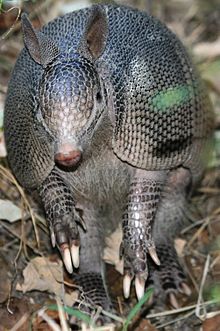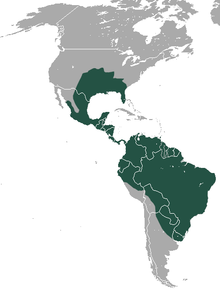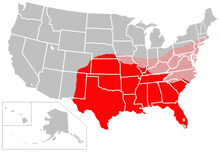| Nine-banded armadillo (Dasypus novemcinctus) | |
|---|---|

| |
| Male in Florida, USA | |

| |
| Female in Nuevo León, Mexico | |
| Scientific classification | |
| Domain: | Eukaryota |
| Kingdom: | Animalia |
| Phylum: | Chordata |
| Class: | Mammalia |
| Order: | Cingulata |
| Family: | Dasypodidae |
| Genus: | Dasypus |
| Species: | D. novemcinctus
|
| Binomial name | |
| Dasypus novemcinctus | |

| |
| Nine-banded armadillo range | |
| Synonyms[2] | |
|
Tatusia novemcincta (Linnaeus, 1758) | |


The nine-banded armadillo (Dasypus novemcinctus), also called the nine-banded long-nosed armadillo or common long-nosed armadillo, is a species of armadillo native to North, Central, and South America, making it the most widespread of the armadillos.[3]
Its ancestors originated in South America, and remained there until the formation of the Isthmus of Panama allowed them to enter North America as part of the Great American Interchange. The nine-banded armadillo is a solitary, mainly nocturnal[4][5] animal, found in many kinds of habitats, from mature and secondary rainforests to grassland and dry scrub. It is an insectivore, feeding chiefly on ants, termites, and other small invertebrates. The armadillo can jump 91–120 cm (3–4 ft) straight in the air if sufficiently frightened, making it a particular danger on roads.[6] It is the state small mammal of Texas.
- ^ Loughry, J.; McDonough, C.; Abba, A.M. (2014). "Dasypus novemcinctus". IUCN Red List of Threatened Species. 2014: e.T6290A47440785. doi:10.2305/IUCN.UK.2014-1.RLTS.T6290A47440785.en. Retrieved November 19, 2021.
- ^ "Dasypus novemcinctus Linnaeus, 1758". Global Biodiversity Information Facility. Retrieved October 29, 2024.
- ^ Gardner, A.L. (2005). "Order Cingulata". In Wilson, D.E.; Reeder, D.M (eds.). Mammal Species of the World: A Taxonomic and Geographic Reference (3rd ed.). Johns Hopkins University Press. pp. 94–95. ISBN 978-0-8018-8221-0. OCLC 62265494.
- ^ Armadillo Observation. Msu.edu. Retrieved on October 17, 2013.
- ^ Mammals of Kansas – Kansas University Archived April 26, 2012, at the Wayback Machine. Ksr.ku.edu. Retrieved on October 17, 2013.
- ^ "How high can a nine-banded armadillo jump?". Everyday Mysteries. Library of Congress.
{{cite web}}: CS1 maint: url-status (link) (dead link 2 November 2024)
